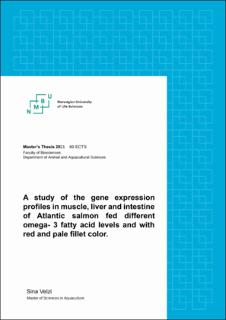| dc.contributor.advisor | Ruyter, Bente | |
| dc.contributor.advisor | Royo, Esmail Lutfi | |
| dc.contributor.advisor | Østbye, Tone-Kari K. | |
| dc.contributor.author | Velzi, Sina | |
| dc.date.accessioned | 2022-10-25T08:48:19Z | |
| dc.date.available | 2022-10-25T08:48:19Z | |
| dc.date.issued | 2022 | |
| dc.identifier.uri | https://hdl.handle.net/11250/3028122 | |
| dc.description.abstract | The economic value of Norwegian salmon production is closely associated with various quality factors of salmon meat like red fillet. Carotenoids are the main pigment in the fish fillet which need to be added to the feed. Astaxanthin is the main carotenoid added to salmon feed but its transport from the intestine to the liver and muscle is not completely understood. However, studies have shown not only transportation of this pigment is dependent on the diet but also, genome-wide association studies (GWAS) showed genomic regions in the salmon genome connected with the variation in fillet redness.
In this experiment, two different diets including a standard feed with a composition like commercial feed and a high Omega-3 fatty acid diet, were fed to two groups of salmon previously selected based on high/low fillet pigment. Further, samples from groups were selected for fillet color analysis by VIS/NIR spectroscopy and astaxanthin measurements. Moreover, genes involved in the metabolism of astaxanthin were studied by microarray and qPCR analysis. In vitro and in vivo trials using Atlantic salmon kidney cell line (ASK) and newly fertilized salmon eggs (1-2 cell stage), were initiated to establish methods to study the function of selected genes using gene editing by the CRISPR/cas9 techniques, respectively. Atlantic
Results showed a significant difference in the expression of bcmo2-like, bcmo2c genes between dietary groups and bcmo1 gene between high and low fillet pigment groups of the intestine. Moreover, a significant difference in expression of the bcmo1-like gene was observed in the liver between the two dietary groups. Finally, a significant difference between bcmo1 and cd36 genes was observed in muscle tissue between dietary groups and bcmo1 between high and low fillet pigment. This study has identified that both the omega-3 fatty acid levels in the feed and differences in muscle pigmentation significantly influenced the expression of several genes related to carotenoid and/or lipid metabolism. The second major finding based on gene expression analyses was that the liver was identified as an important organ in astaxanthin metabolism.
Taking all together, astaxanthin metabolism might be organ dependent in Atlantic Salmon. Moreover, further research should focus on the establishment of efficient CRISPR/cas9 techniques in ASK cell and salmon embryos to further confirm current results. | en_US |
| dc.language.iso | eng | en_US |
| dc.publisher | Norwegian University of Life Sciences, Ås | en_US |
| dc.rights | Attribution-NonCommercial-NoDerivatives 4.0 Internasjonal | * |
| dc.rights.uri | http://creativecommons.org/licenses/by-nc-nd/4.0/deed.no | * |
| dc.title | A study of the gene expression profiles in muscle, liver and intestine of Atlantic salmon fed different omega- 3 fatty acid levels and with red and pale fillet color | en_US |
| dc.type | Master thesis | en_US |
| dc.description.version | submittedVersion | en_US |
| dc.subject.nsi | VDP::Agriculture and fishery disciplines: 900 | en_US |
| dc.source.pagenumber | 79 | en_US |
| dc.description.localcode | M-AA | en_US |

